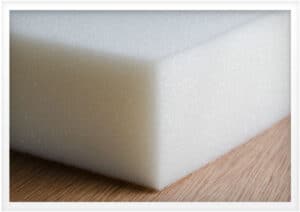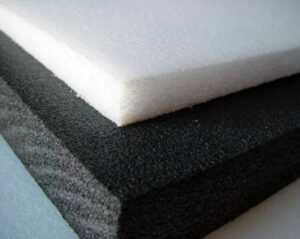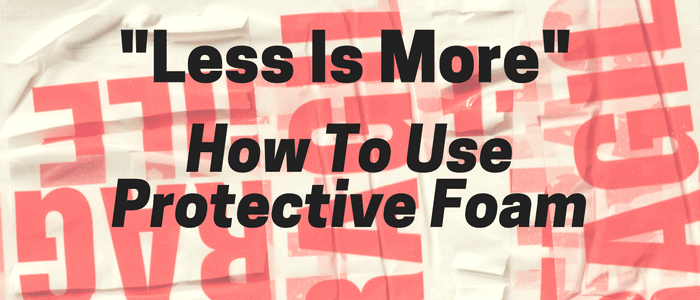When Less Is More: Using Foam To Protect Valuable Products In Shipment
Sometimes too much of a good thing is a bad thing, like chocolate cake, Christmas decorations, cheese and… protective foam.
That’s right – there IS such a thing as too much protective foam.
With protective foam, less is often more. Using foam in an expert and knowledgeable way means being economical with it, in order to increase its effectiveness. In this article we’ll cover some of the basics of foam packaging: the hazards of shipment, the types of foam that protect against those hazards, and the principles of foam packaging design. When it comes to transporting valuable machinery and other products, intelligent foam design is what stands between a safe shipment and a disastrous one.
The Hazards
During shipment, a package will be exposed to many different types of hazards. Protective foam will be effective in mitigating the effects of three different types of hazards: impact (or shock), vibration, and compression.
Impact occurs when a package is dropped or when it is struck by (or strikes) another package. This is the leading cause of damage and most packaging is designed to protect against impact.
Vibration refers to the mechanical vibration caused by the motors and engines that move the package (trucks, airplanes, ships). Rail travel often causes the most vibration along with intense jostling and bouncing. Vibration can result in many different kinds of damage, including abrasion, loosening of fasteners and closures, and the loss of structural integrity of the package or product.
Compression refers to the force that other packages exert on the package in transit. There may be pressure on the top as well as the sides of the package and this can result in all kinds of structural problems for the packaging.
It’s worth noting that even when packages bear explicit instructions like “Do Not Stack,” “Top Load Only,” “Fragile,” “Keep Upright,” — these warnings are often foregone due to space and time constraints on the shippers. Luckily, protective foam is a line of defense for all of these potential hazards and learning how to use it is essential for safe shipping of products.
Types of Foam
Foam is the result of introducing gas bubbles into a polymer. It’s a fairly ubiquitous, lightweight material and comes in a variety of types. There are many types of foam, but we will cover the two most used types in our crating industry.
Polyurethane

- Lightweight, open-cell foam.
- Sponge-like: absorbs water and moisture.
- Ideal for lighter objects or to provide one protective layer among other types of materials.
- Abrasion resistant, and regains its shape quickly after impact.
- Can provide protection from vibration damage in many cases.
- Difficult to clean (due to absorptive capacity)
Polyethylene

- Lightweight and durable closed-cell foam.
- More rigid than polyurethane.
- Ideal for heavier objects and for blocking or bracing.
- Does not absorb water.
- Good for some types of vibration protection.
- Easy to clean.
Principles of Foam Protection Design: The Best Protection is AIR.
In designing foam protection for your product, there’s one principle that you can always count on:
The best protective substance for your product is not foam, but air.
In good foam protection design, the foam is being used on the least fragile parts of the product in order to use air to protect the most fragile parts. This leads to an idea that may seem paradoxical: simply putting foam everywhere around a product can actually expose it to more damage.
To illustrate this, we’ll use an example. Let’s say you want to ship a large, valuable glass tube. The shipment needs to be protected from compression and from the potential of a shock or impact. You’re going to package it in a rectangular wood crate, but you’re not sure exactly how to use foam to provide the optimal protection. Should you have the glass tube resting on a layer of thick foam to cushion its impact? Or should you only use foam on the edges and leave the middle of the tube without a foam layer? What would be the better design solution?

The answer is that you should only put foam on the ends and leave the middle protected by air only. The reasoning is simple: the ends are the most impact resistant part of the tube. They can take the most force due to the principles of tensile strength. The middle is the least impact-resistant part. If you put a layer of foam along the entire length of the tube then when the package is dropped, the force will be distributed along the length of the tube and can hit the tube in its most fragile section. If you put the foam only at the ends, then when the package is dropped the ends will be protected by foam, which will allow the middle to only impact with air, keeping the force of the drop the lowest it can possibly be in the most fragile area of the product.
Economical and Smart
When you get an electronic device and the ends and corners are protected, but the middle is left “unprotected” it isn’t because the company is trying to save money on packaging. It’s because they are using air to protect the most fragile part of the product. It may sound strange, but thinking of air as your best protective layer is the first step to understanding the complexities of protective foam design.
Get in touch and we’ll provide the maximum protection to your valuable machinery and other products.

